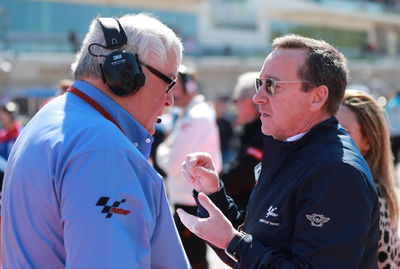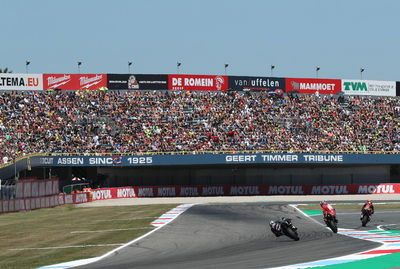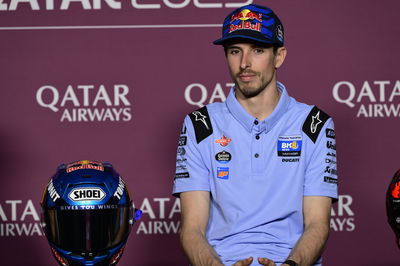FIM investigating 'possible breach of testing rules' - UPDATED
The FIM MotoGP Stewards are to investigate possible breaches of the motorcycle grand prix rules regarding practice and testing.
No names or classes have been released, but an FIM statement said it is 'specifically… regarding the type of machines permitted for rider training'.
In other words, the FIM suspect that some riders have been using training machinery deemed too similar to their grand prix bike, or the FIM were not informed of legal modifications made to the training bike.

The FIM MotoGP Stewards are to investigate possible breaches of the motorcycle grand prix rules regarding practice and testing.
No names or classes have been released, but an FIM statement said it is 'specifically… regarding the type of machines permitted for rider training'.
In other words, the FIM suspect that some riders have been using training machinery deemed too similar to their grand prix bike, or the FIM were not informed of legal modifications made to the training bike.
'Hearings for riders who may have broken the rules should be scheduled to take place at the 2020 Gran Premio Red Bull de España at the Circuito de Jerez-Angel Nieto, in order to hear from the parties concerned and to allow further time to investigate the details,' an FIM statement added.
Although some safety changes can be made to 'standard production road-homologated motorcycles' for training purposes, the modifications 'must be notified to the Technical Director in advance'.
With that in mind, and given today's FIM statement, questions are now being raised about the specification and prior-notification status for this R1 used recently by Fabio Quartararo:
Although not prepared to comment specifically on any particular rider, MotoGP Technical Director Danny Aldridge told Crash.net that anyone planning to participate in training on a tarmac circuit should seek pre-approval of the motorcycle they are intending to use and, especially, the changes they have made over the standard road-homologated version. Such pre-approval avoids any risk of accidentally breaking the rules.
Nonetheless, since Paul Ricard is not a current grand prix circuit and even a race-spec R1 is a long way from his MotoGP-spec M1 on prototype Michelin tyres, it seems unlikely that Quartararo could have gained any advantage for the MotoGP season even if he breached the 'prior notification' rules.
In the past, penalties (usually missing part of Friday practice) have only been given for those illegally testing with a grand prix bike or using a road bike inside the two-week window before a grand prix at the same track, both of which could provide an unfair advantage.
Quartararo's Petronas Yamaha team would not comment on speculation over the R1 ride, also meaning no denial of the rumours, saying only that by posting all of his training sessions on social media there is no intention to hide anything from anyone.
Either way, there are believed to be at least two riders currently under investigation by the FIM.
The full FIM statement and wording of Article 1.15.1. c) of the Grand Prix Regulations can be seen below.
'The FIM MotoGP Stewards have been advised of possible breaches of the FIM Grand Prix Regulations covering practice and testing, specifically Article 1.15.1. c) Rider Training and Track familiarisation, regarding the type of machines permitted for rider training.
'As a reminder and following the decision of the Grand Prix Commission published on 27 May 2020, riders in Moto3 and Moto2 classes are not permitted to make further private testing in 2020 until further notice, the same applies to MotoGP class riders unless they are riding for Manufacturers that qualify for concessions. Practice and testing restrictions for all classes are expressly provided for in Article 1.15.1 of the FIM Grand Prix Regulations, including details of what machines are allowed to be used for Rider Training and Track Familiarisation.
'Hearings for riders who may have broken the rules should be scheduled to take place at the 2020 Gran Premio Red Bull de España at the Circuito de Jerez-Angel Nieto, in order to hear from the parties concerned and to allow further time to investigate the details.
'At this stage the FIM will not make any further comments on this matter.'
Grand Prix Regulations - Practice and Testing Restrictions: Article 1.15.1. c)
Rider Training and Track Familiarisation is permitted at any time at any circuit under the following conditions:
i) Such on-track activity is not permitted within the 14 days before a GP event at a circuit unless authorised by Race Direction.
ii) For motorcycles of the same capacity class as the rider is entered in, only standard production road-homologated motorcycles may be used.
For safety it is permitted to make the following changes, which must be notified to the Technical Director in advance:
• Wheels
• Brake calipers, master cylinders, lines and discs (carbon discs are not permitted)
• Front and rear suspension
• Removal of existing parts (eg. mirrors, lights, etc.)
• Tyres (commercially available tyres as approved by the Technical Director, NB. current specification of championship tyres are not permitted)
• Footrests, handlebars and control levers
• Exhaust
• Replica Bodywork in a different material is permitted, but the design must be identical to the original (except for blanking areas for removed lights, etc.)
NB. Motorcycles of non-roadracing disciplines (eg. Motocross, Enduro, SuperMoto) and roadracing machines of a different capacity class, as approved by the Technical Director, may be used without restriction (note that here, “capacity class” refers to racing class designation not just the cubic capacity, and the Technical Director will be the sole judge of eligibility of machines to be used).
Race Direction may grant an exemption for specific events using race machines of the same capacity class the rider is entered in. Such authorisation must be requested in advance.
iii) In the Moto2 class, when track familiarisation takes place on a Grand Prix circuit then the road-homologated motorcycle may not be the same brand and within 100cc of the same engine capacity as the current Moto2 official engine supplier (or an announced future supplier). That is, if the motorcycle is the same brand as the official Moto2 engine supplier, it must be of a different engine capacity by 100cc or more to the official Moto2 engine.
iv) In the Moto3 class, when track familiarisation takes place on a Grand Prix circuit then the road-homologated motorcycle may not be the same brand and within 50cc of the same engine capacity as the rider’s current Moto3 machine. That is, if the motorcycle is the same brand as the rider’s current Moto3 machine, it must be of a different engine capacity by 50cc or more.
v) In case of dispute regarding machine eligibility the decision of the Technical Director will be final.












